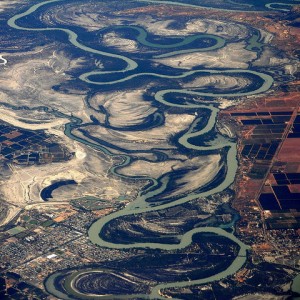Federal Water Tap, May 19: EPA Recommends New Water Quality Standards for Chemical Pollutants
How much benzene should be allowed in a liter of river water? Or how about vinyl chloride? The U.S. Environmental Protection Agency has a new answer for 94 federally regulated chemicals, though states and tribes will be the ultimate arbiters.
The EPA is updating human health benchmarks for chemical concentrations in rivers, lakes, and streams – benchmarks that were established as far back as the 1970s for some pollutants.
The draft guidelines are just that – a guide. In general, states and tribes set the enforceable water quality standards for waterways within their boundaries, and they must review these standards every three years. The EPA is providing updated guidelines, which have moved both up and down depending on the chemical. (This chart compares current and proposed standards.)
For instance, recommended limits for one of the most widely used weed killers in the United States, called 2,4-D, will double, to 200 micrograms per liter.
The mathematical foundation for the new standards, based on contamination via water-drinking and fish-eating, has changed. For one, they assume a larger person: 80 kilograms, up from 70 kilograms. Notions about fish consumption are also different. The new standards are based on eating 22 grams per day, up from 17.5 grams.
Comments on the changes are being accepted through July 14. Send them to ow-docket@epa.gov, referencing docket number EPA-HQ-OW-2014-0135 in the subject line.
Selenium Guidelines
The EPA is also proposing new selenium guidelines that will protect fish and birds. Selenium, a byproduct of coal-burning, is toxic in large quantities to fish and to the birds that eat fish, resulting in birth deformities.
More nuanced than current benchmarks, which were set in 1999, the new guidance proposes numeric targets for fish tissues and waterways. Like the water quality standards, states and tribes are responsible for acting on the selenium advice.
The guidelines are open for public comment, after which they will be submitted for peer scientific review. Send comments by June 13 to ow-docket@epa.gov, referencing docket number EPA–HQ–OW–2004–0019 in the subject line.
Water Resources Bill
After many months, the House and Senate resolved their differences and produced compromise legislation that funds the nation’s ports and flood control systems.
The bill, a mission statement of sorts for the Army Corps of Engineers, takes away more than it bestows. It authorizes $US 12 billion in new projects, while it directs the Army’s chief executive to erase projects worth at least $US 18 billion from its books. The secretary is to do this by eliminating projects authorized before 2007 that have not begun construction, then proceeding to those that have not received funds in the last six years.
Also in the 532-page bill is a pilot water infrastructure funding program called WIFIA, which is modeled after a federal transportation program. WIFIA targets water projects that cost more than projects typically funded by existing federal loan programs.
California Drought
The Obama administration is holding weekly drought calls with California officials and federal agencies working in California, a White House official told Circle of Blue.
The calls, which began February 2, are designed to ensure that agencies are on the same page. For now that means moving water more quickly between willing buyers and sellers and pinpointing where federal assistance is most needed, including unemployment, housing, and food aid.
“This close coordination allows for early awareness of upcoming issues, ensuring that assistance to farmers, ranchers, and others most vulnerable to drought impacts flows as quickly as possible,” the White House official said.
Coal Power in Navajo Land
The Bureau of Reclamation will prepare an environmental review of the Navajo Generating Station – one of the largest coal-fired power plants in the American West – and of its source mines, located on Navajo and Hopi land. The 2,250-megawatt power plant supplies nearly all the electricity to operate the Central Arizona Project, which moves Arizona’s share of the Colorado River some 540 kilometers (336 miles) inland.
The environmental review will analyze the air, land, health, and water effects of extending multiple operating permits through 2044. Send comments about the scope of the study to NGSKMC-EIS@usbr.gov by July 7.
Federal Water Tap is a weekly digest spotting trends in U.S. government water policy. To get more water news, follow Circle of Blue on Twitter and sign up for our newsletter.
Brett writes about agriculture, energy, infrastructure, and the politics and economics of water in the United States. He also writes the Federal Water Tap, Circle of Blue’s weekly digest of U.S. government water news. He is the winner of two Society of Environmental Journalists reporting awards, one of the top honors in American environmental journalism: first place for explanatory reporting for a series on septic system pollution in the United States(2016) and third place for beat reporting in a small market (2014). He received the Sierra Club’s Distinguished Service Award in 2018. Brett lives in Seattle, where he hikes the mountains and bakes pies. Contact Brett Walton





Leave a Reply
Want to join the discussion?Feel free to contribute!